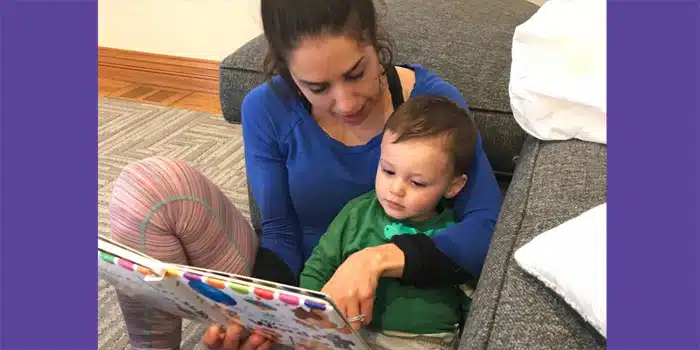Hi there! I’m Katie Dimond, mom of 2 boys, speech pathologist, and founder/director of Dimond Therapy and Tutoring Group. I am a huge advocate of reading. My mom and dad always read to me as I was growing up and it instilled a love for reading. Reading sparks the imagination and it inspires creativity, increases vocabulary, and teaches you spelling and grammar.
I love reading with my kids and because of that they love books. It is never too early to start reading to your children – even before they are born! They recognize your voice and the sound of your voice is comforting to them, even in the womb. Talking, reading, and playing a variety of music can help stimulate baby’s senses and improve brain development, according to Dr. Michael Roizen.
Not sure where to start?
You might be unsure what books to read, which books are appropriate for their age group, or how to get your child to sit still for a story. Check out my tips and personal experiences to maximize reading to your little ones and increase speech development and language learning.
Mason, my first child, loved books. I started reading to him the day he was born – in the swing, bouncer, during tummy time, on the couch, while eating, and before bed… all the time. It turns out he was an early talker, speaking in full-sentences by 20-months. Miles, my second child, is 16-months-old and only has a few words. I have not read to him as much as I did to Mason, but now I am really kicking up the reading by finding ways to work it into our daily routine.
Opportunities to add reading to your daily routine
Bedtime
I recently started reading to my son in his crib before he goes to bed, and let me tell you, he loves it! He is excited to go to bed at night and goes to his room to choose his stories. Climbing into this little guys crib isn’t the easiest but he seems to be developing more words and sounds from this extra special reading time together.
Mealtime
I read to my kiddos while they are eating. Kids can eat for a long time. Once you run out of things to talk about it could be a good time to read them a story and then talk about the story. It can get your books really messy if you have a kid who likes to grab the book and touch it but, reading while eating could be a good time to get a few extra stories in.
Tummy time
Books are perfect for tummy time! Set up books in the standing position for your baby to look at while in tummy time. You can also read them books or tell the story of the pictures while they are in tummy time, in a swing, sitting in a bumbo, or while you are holding them.
On the go
Try carrying some small lightweight books in your diaper bag. You would be surprised how many good opportunities arise during the day where you can throw in a book.
Tips and tricks to maximize your reading time
Read face to face
A good strategy for reading to your little one is read face to face. It is helpful for your child to see your mouth move when you are talking. That way they can see you producing words and watch your articulators move to produce certain sounds. Also, looking at your child’s face when you are reading helps so you can point to objects on the pace when talking about them and watch your child look at them as well, and you can look at your child in the eyes and ensure joint attention is happening, the shared focus of two individuals on an object or person.
Switch it up
There is more than one way to read a book. You do not have to start at the beginning, you can skip pages or not finish the book, you can just talk about the pictures and not read the words, you can change the words, you can read the same book over and over again, even in one sitting.
Change roles
Give your child a chance to take turns reading. Let them hold the book and point to things or babble. Tell them what they are pointing to but give them about 5-seconds before talking to let them complete their communication about the book. Wait approximately three to five seconds to give your child a chance to respond to what you have asked or said. Show that you are waiting expectantly by raising your eyebrows, smiling, and opening your mouth. Observe, wait, and listen to your child as they are reading, pointing, or holding the book.
Stress your own speech
Highlight your language as you are reading and make words stand out. Stress important words. Point to objects you are talking about. Go slow when you are talking to give your child a chance to understand what you are saying. Over emphasize the words and repeat a few times. Add words to describe what has captured your child’s interest.
I hope these strategies are helpful for you! Check out my blog on reading recommendations by age if you’re looking for new book suggestions.

Katie Dimond
Katie Dimond is the founder and director of Dimond Therapy and Tutoring, offering therapy services to kids from birth through high school at Bubbles Academy and in the Chicago area. Katie, mom of 2, is a dedicated, experienced, and licensed speech and language pathologist. She has been practicing since 2008 and has extensive experience treating children with speech and language delays and disorders. She received her Bachelor’s degree in Speech and hearing Science at the University of Illinois in 2006 and received her Master’s degree in Communication Science and Disorders from Saint Louis University in 2008. Katie is a certified speech and language pathologist in the state of Illinois, a member of the American Speech-Language and Hearing Association, and owns Crossroads Speech Therapy in Chicago.
